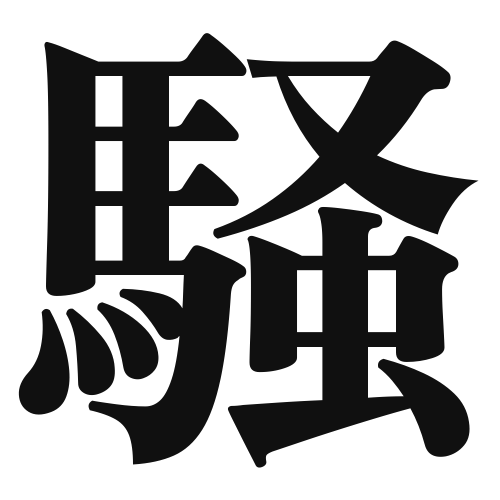1. Overview of Meaning
The kanji “騒” (sō) means “to make noise” or “to be noisy.” It often conveys a sense of commotion or disturbance, whether in a physical or social context.
2. Formation and Radical
Formation of the Kanji: The kanji “騒” is a phonetic-ideographic character (形声文字). It combines the radical for “horse” (馬) on the left, which relates to the sound of a horse, and the phonetic component “巢” (sō) on the right, which contributes to its pronunciation.
Radical: The radical of “騒” is “馬” (uma), which means “horse.” This radical often relates to sounds or movements associated with horses.
3. Examples of Usage
Common Words and Phrases: Some frequently used words that include “騒” are:
- 騒音 (sōon) – noise
- 騒がしい (sōgashii) – noisy
- 騒動 (sōdō) – disturbance or uproar
Example Sentences in Daily Conversation:
- この場所は騒がしいですね。 (Kono basho wa sōgashii desu ne.) – This place is noisy, isn’t it?
- 騒音が気になる。 (Sōon ga ki ni naru.) – I’m bothered by the noise.
4. Synonyms and Antonyms
Similar Kanji: A similar kanji is “喧” (ken), which also means “noisy” but often implies a more chaotic or disruptive noise, such as in “喧嘩” (kenka – fight).
Opposite Kanji: The opposite kanji is “静” (shizu), meaning “quiet” or “calm.” It represents the absence of noise or disturbance.
5. Cultural and Historical Background
Relation to Japanese Culture: The concept of noise and disturbance is significant in Japanese culture, especially in urban areas where noise pollution can be a concern. Festivals often involve loud music and celebrations, highlighting the dual nature of noise in society.
Proverbs and Idioms: An example of an idiom is “騒がしい時に静かにする” (sōgashii toki ni shizuka ni suru), which means “to remain calm in a noisy situation,” emphasizing the value of composure amidst chaos.
